Irish Wolfhound Dog Beds
Irish Wolfhound’s Need an Orthopedic Bed!
Introduction
Irish Wolfhound dog beds take into account their health conditions, sleeping style, and preferences. Because of their size, an orthopedic bed is recommended.
The Irish Wolfhound is a breed of majesty, history, and gentle companionship. Known for their towering height and noble presence, these dogs were once bred for hunting wolves and big game in Ireland. Despite their formidable appearance, they are among the gentlest and most affectionate breeds, often referred to as gentle giants.
Owning an Irish Wolfhound is a rewarding experience, but it comes with unique responsibilities. As a giant breed, they have specific health, exercise, and dietary needs that differ from smaller dogs.
Their short lifespan (6–8 years) means every moment counts, and providing the best care ensures they live happily and comfortably. Understanding their gentle but independent nature will help foster a strong bond while ensuring their physical and emotional well-being.
Whether you’re considering bringing home an Irish Wolfhound or have already welcomed one into your family, this guide will help you navigate the joys and challenges of owning one of the world’s most majestic and loving breeds.
This guide includes everything new owners needs to know about including facts, fun facts, health issues, common behaviors, tips for new owners, costs of ownership, best bed types, brands, safe foods and foods to avoid.
Video: Pros and Cons
In this video, you will learn some of the pros and cons of owning an Irish Wolfhound.
Best Dog Bed Types for Irish Wolfhounds
- Orthopedic Memory Foam Bed – Provides excellent joint support, ideal for large breeds prone to hip and elbow dysplasia. Look for high-density foam to support their weight. When shopping for a memory foam bed be to look for the CertiPUR-US certification seal.
- XXL Pillow-Style Bed – A large, flat, and cushiony bed allows them to stretch out fully, which is essential for their comfort.
- Bolster Bed – Offers extra support around the edges, giving them something to rest their head on while keeping their spine aligned.
- Elevated Cot Bed – Ideal for hot climates, these beds improve airflow, help keep them cool and prevent pressure sores.
- Waterproof or Washable Beds – Irish Wolfhounds drool and shed, so easy-to-clean beds with waterproof liners are a must.
- Cooling Gel Foam Bed – Great for summer months or Wolfhounds who tend to overheat due to their size and thick coat.
- Extra-Large Sofa-Style Bed – Provides the ultimate lounging experience, with plush cushioning and sturdy support.
- Heated Dog Bed – Helps soothe arthritic joints and is perfect for cold weather or senior Wolfhounds.
- Nest/Donut Bed – Works well for Wolfhounds who like to curl up, though it needs to be big enough to accommodate their size.
- Mattress-Style Bed with Support Foam – A thick and firm mattress is better than a thin, soft bed that can flatten under their weight.
- Memory Foam Crate Pad – If your Wolfhound sleeps in a crate, an extra-thick crate pad ensures comfort and support.
- Customized XL Dog Bed – Some owners opt for custom-built beds to meet the unique needs of their giant pup.
Bonus Tips for Choosing a Bed:
- Size Matters – Look for beds 50 inches or longer to fit their entire body.
- Thickness is Key – At least 4–6 inches of memory foam is recommended.
- Durable Cover – Heavy-duty, tear-resistant covers help withstand their weight and occasional nesting behavior.
- Non-Slip Bottom – Prevents sliding when your giant dog gets up or lays down.
Best Dog Bed Brands
The best dog bed brands for Irish Wolfhounds include the following:
- Big Barker – Designed specifically for giant breeds, their 7-inch orthopedic foam beds provide excellent joint support and durability.
- Furhaven – Offers XXL bolster beds and cooling gel foam options, great for both comfort and heat regulation.
- K9 Ballistics – Known for their chew-resistant and durable beds, ideal for Wolfhounds who like to nest or scratch before lying down.
- Kuranda – Makes elevated cot-style beds, perfect for cooling and relieving joint pressure.
- BarksBar – Provides affordable orthopedic options with memory foam and plush bolsters.
- PetFusion – Features thick orthopedic beds with waterproof liners and machine-washable covers.
- Laifug – Offers high-density memory foam beds that retain their shape and support over time.
- Brindle – Specializes in thick orthopedic crate pads, great if the Wolfhound sleeps in a crate.
- Frisco (Chewy Brand) – Has XXL pillow-style and orthopedic beds at a more budget-friendly price.
- Serta Orthopedic Dog Beds – Uses human-grade memory foam, ensuring great joint support.
- Majestic Pet – Makes huge pillow-style beds with durable covers, great for Wolfhounds who love to sprawl.
- The Dog’s Bed Orthopedic – Offers extra-large, high-density foam beds with waterproof and removable covers.
What to Look for in a Bed Brand:
- XXL Sizes (50+ inches long)
- Orthopedic Support (Memory foam at least 4–6 inches thick)
- Durability (Chew-resistant, heavy-duty covers)
- Washable Covers (Easy to clean)
- Non-Skid Bottoms (Prevents slipping on hardwood floors)
Facts About the Irish Wolfhound
Information
- Size: Giant
- Group: Hound Group
- Height Males: 32 inches
- Height Females: 30 inches
- Weight Males: 120 lbs.
- Weight Females: 105 lbs.
- Length Males: 46 – 50.5 inches
- Length Females: 46 – 50.5 inches
- Lifespan: 6 – 8 years
- Fully Grown: 2 years
- Colors: Black, Brindle, Cream, Gray, Gray & Brindle, Red, Red & Brindle, Red Wheaten, Silver, Wheaten, Wheaten & Brindle, Blue, and White
- Popularity: This dog breed is ranked the 73rd most popular in the United States by the American Kennel Club in 2023.
- Intelligence: This breed is ranked the 41st most intelligent by Stanley Coren.
Additional Facts:
- Ancient Breed – The Irish Wolfhound dates back to at least 391 AD and was originally bred by the Celts for hunting wolves and large game.
- Tallest Dog Breed – They are the tallest dog breed in the world, with males reaching up to 35 inches at the shoulder.
- Gentle Giant – Despite their massive size, they are known for their calm and affectionate temperament.
- Short Lifespan – Irish Wolfhounds typically live between 6 to 8 years, which is shorter than many other breeds due to their large size.
- Used in Battle – In ancient times, they were used in warfare to pull enemies off horseback and guard their owners.
- Great With Families – They are very gentle with children and make excellent family dogs, though their size requires supervision with small kids.
- Low Aggression – They rarely show aggression, which makes them poor guard dogs despite their imposing size.
- Fast Runners – They can reach speeds of around 40 mph, making them one of the fastest large breeds.
- Minimal Barking – Unlike some other large breeds, they are not big barkers and tend to be relatively quiet.
- Needs Space – While they can adapt to indoor living, they need plenty of room and regular exercise due to their size.
- Historical Prestige – Irish Wolfhounds were once exclusively owned by nobility and were gifted to kings and emperors.
- Susceptible to Bloat – Like many deep-chested breeds, they are prone to gastric torsion (bloat), which can be fatal if not treated quickly.
Fun Facts
- Appears in Mythology – The breed is mentioned in Irish legends, including the story of Cú Chulainn, a warrior named after his wolfhound.
- The Dog of Kings – Irish Wolfhounds were given as gifts to famous figures, including Julius Caesar and Henry VIII.
- Soft Heart Despite the Size – They are known as “gentle giants” because they are incredibly affectionate and love to cuddle.
- Hollywood Star – Irish Wolfhounds have appeared in movies and TV shows, including Game of Thrones and The Sandlot.
- One of the Rarest Breeds – Despite their ancient lineage, they remain one of the rarest purebred dogs in the world
- Their Tail is as Long as a Small Dog – Some Irish Wolfhounds have tails over 2 feet long!
- Not the Best Swimmers – Unlike some large breeds, they are not particularly strong swimmers due to their build and weight.
- Big Paws = Big Growth – A puppy’s paws can be huge compared to its body, indicating how massive they will grow.
- Lazy Indoors – While they need exercise, many Irish Wolfhounds are couch potatoes who love lounging around.
- Inspiration for Mascots – Several universities, including Loyola University Maryland, have an Irish Wolfhound as a mascot.
- Recognized in 1879 – The first breed standard for the Irish Wolfhound was written in 1879 by Captain George Augustus Graham, who revived the breed.
- They Can Outgrow Some Humans! – When standing on their hind legs, some Irish Wolfhounds can reach 7 feet tall or more—taller than most people!
Common Health Issues
Here are the most common health issues that Irish Wolfhounds are prone to:
- Dilated Cardiomyopathy (DCM) – A serious heart condition where the heart becomes enlarged and weak, leading to heart failure.
- Bloat (Gastric Dilatation-Volvulus, GDV) – A life-threatening condition where the stomach twists, trapping gas and cutting off blood flow. Immediate veterinary care is required.
- Hip Dysplasia – A genetic condition where the hip joint doesn’t fit properly, leading to arthritis and mobility issues.
- Elbow Dysplasia – A developmental disorder in the elbow joint that can cause pain and lameness.
- Osteosarcoma (Bone Cancer) – A highly aggressive form of bone cancer that is unfortunately common in giant breeds.
- Hypothyroidism – A condition where the thyroid gland doesn’t produce enough hormones, leading to weight gain, lethargy, and skin issues.
- Liver Shunt (Portosystemic Shunt, PSS) – A congenital issue where blood bypasses the liver, preventing proper detoxification.
- Progressive Retinal Atrophy (PRA) – A degenerative eye disease that can lead to blindness over time.
- Von Willebrand’s Disease – A blood clotting disorder that can cause excessive bleeding from minor injuries or surgeries.
- Pneumonia – Irish Wolfhounds are more susceptible to a form of pneumonia called aspiration pneumonia, especially after anesthesia.
- Arthritis & Joint Issues – Due to their massive size, they are prone to early-onset arthritis and need supportive bedding and joint supplements.
- Megaesophagus – A condition where the esophagus doesn’t move food properly, leading to regurgitation and possible aspiration pneumonia.
Preventative Tips for New Owners:
- Heart Screenings – Regular echocardiograms can help detect DCM early.
- Bloat Prevention – Feed multiple small meals per day, avoid exercise after eating, and consider a gastropexy surgery for prevention.
- Joint Health Support – Provide glucosamine, chondroitin, and omega-3 supplements to support aging joints.
- Regular Vet Checkups – Early detection of cancer, thyroid issues, and vision problems can improve their quality of life.
- Genetic Testing – Responsible breeders test for hip dysplasia, PRA, and Von Willebrand’s disease to reduce the risk of inherited issues.
Common Behaviors
Here’s a list of common behaviors in Irish Wolfhounds that new owners should know:
- Gentle Giants – Despite their massive size, they are incredibly gentle, affectionate, and loving with their families.
- Loyal but Not Overly Protective – They are deeply devoted to their owners but are not natural guard dogs due to their friendly nature.
- Laid-Back Indoors – Irish Wolfhounds can be lazy and love lounging, but they still need regular exercise to stay healthy.
- Fast Sprinters, But Not Endurance Runners – They love short bursts of running but do not have the stamina for long-distance jogging.
- Strong Prey Drive – As a sighthound, they may chase small animals like squirrels, cats, or rabbits, so a fenced yard is ideal.
- Good With Children – They are typically gentle and patient with kids, but their size means they can accidentally knock over small children.
- Slow to Mature – Mentally, they remain puppy-like for up to 2–3 years, despite growing to full size quickly.
- Can Be Stubborn – They are intelligent but may be independent-minded, requiring consistent, positive reinforcement training.
- Not Excessive Barkers – Generally, Irish Wolfhounds are quiet dogs and do not bark often, unless there’s a real reason.
- Need Space to Stretch Out – They love sprawling out and may take over couches, beds, and any soft surface they find.
- Social and People-Oriented – They prefer to be around their humans and may experience separation anxiety if left alone for long periods.
- Love to Lean – A classic Irish Wolfhound behavior is to lean against their humans, a sign of trust and affection.
Some Additional Tips:
- Secure Fencing is Important – They can be chase-prone and need a safe enclosed area to run.
- Give Them a Soft Spot – Their thin coats and bony joints make soft bedding essential for comfort.
- Supervise Around Small Pets – Due to their prey drive, they may not be the best fit for homes with small animals.
Tips for New Owners
1. Training & Socialization
- Start Training Early – They grow fast, so teach leash manners, commands, and boundaries while they’re still small.
- Use Positive Reinforcement – They are sensitive dogs and respond best to praise, treats, and gentle guidance.
- Early Socialization is Key – Introduce them to different people, environments, and sounds to prevent fearfulness. Exposing them to new people, places, and animals helps them stay well-adjusted.
- Teach Recall – Since they have a strong prey drive, reliable recall training is crucial before allowing off-leash time.
- Be Patient with Stubbornness – They are smart but independent, so consistent training is necessary.
2. Exercise & Space Needs
- Daily Walks Are Essential – While they are laid-back indoors, they still need at least 45–60 minutes of daily exercise.
- Fenced Yards Are Best – They can chase small animals due to their sighthound instincts, so secure fencing is recommended.
- Limit Jumping in Puppies – Growing Irish Wolfhounds are prone to joint issues, so avoid excessive running or jumping on hard surfaces.
- Short Sprints Over Long Runs – They enjoy a good sprint but do not have the endurance for long-distance running.
- Mental Stimulation is Important – They enjoy puzzle toys, training exercises, and interactive play to stay engaged.
3. Health & Nutrition
- Feed a High-Quality Diet – Choose a large or giant breed formula with controlled calcium & phosphorus to prevent rapid bone growth issues.
- Prevent Bloat (GDV) – Feed smaller meals multiple times a day, use a slow feeder, and avoid exercise right after eating.
- Monitor for Heart Disease – Regular heart checkups help detect dilated cardiomyopathy (DCM) early.
- Joint Supplements Help – Adding glucosamine, chondroitin, and omega-3s can support their joints.
- Vet Checkups Are Crucial – Regular vet visits help catch bone cancer, thyroid issues, and heart conditions early.
4. Grooming & Care
- Brush Weekly – Their rough, wiry coat needs brushing at least once a week to prevent matting and remove loose hair.
- Trim Nails Regularly – Long nails can cause joint pain in giant breeds, so trim them every 2–3 weeks.
- Check Their Ears – Clean their large, floppy ears weekly to prevent infections.
- Provide Soft Bedding – Their large frame makes orthopedic beds a must to prevent pressure sores and joint pain.
- Bathe When Needed – They don’t have a strong odor, so only bathe them every few months or as needed.
5. Living with an Irish Wolfhound
- Expect a Couch Hog – They love to sprawl out and may take over your furniture if allowed.
- Supervise Around Small Pets – Their prey drive makes them likely to chase cats or small dogs if not raised with them.
- Irish Wolfhounds Are Velcro Dogs – They bond closely with their owners and don’t like being left alone for long periods.
- They Are Not Guard Dogs – Despite their size, they are usually too friendly to be effective protectors.
- Enjoy Every Moment – Their lifespan is short (6–8 years), so cherish the time you have with them.
Final Thought:
Irish Wolfhounds are gentle, loving, and loyal dogs that require proper training, exercise, and health care to thrive. With the right environment and love, they make amazing companions!
Costs of Ownership
Below are some of the average costs of owning an Irish Wolfhound:
1. Initial Costs (One-Time Expenses)
- Puppy Price (from a reputable breeder): $2,000 – $3,500+
- Adoption Fee (rescue organizations): $300 – $600
- Initial Vet Exams & Vaccinations: $150 – $300
- Spay/Neuter Surgery: $250 – $600
- Microchipping: $ 50 – $100
- Crate (XXL Size): $200 – $500
- Dog Bed (Orthopedic, Size XXL): $100 – $400
- Food & Water Bowls: $ 30 – $ 80
- Leash, Collar & ID Tags: $ 50 – $100
- Basic Training Classes: $150 – $500
- Toys & Chews: $ 50 – $150
- Grooming Supplies: $ 50 – $150
Total Initial Costs: $3,500 – $7,000
2. Ongoing Annual Costs
- Food (High Quality): $1,500 – $2,500
- Routine Vet Visits & Vaccinations: $ 300 – $ 600
- Heartworm & Flea/Tick Prevention: $ 200 – $ 500
- Pet Insurance: $ 600 – $1,500
- Grooming (DIY or Professional): $ 100 – $ 400
- Toys & Enrichment: $ 100 – $ 300
- Dog Bed Replacement: $ 100 – $ 400
- Treats, Cleaning Supplies: $ 200 – $ 500
Total Yearly Costs: $3,000 – $6,500+
3. Potential Extra Costs
- Emergency Pet Visits: $ 500 – $ 1,000
- Hip Dysplasia Surgery: $3,000 – $ 5,000
- Bloat (GDV) Surgery: $3,500 – $ 7,000
- Cancer Treatments: $2,000 – $10,000
- Advanced Heart Screenings: $1,000 – $ 5,000
- Professional Training (As Needed): $ 500 – $ 2,000
- Boarding or Dog Sitting (Year): $ 300 – $ 1,000
Total Extra Costs: $10,800 – $38,000
Total Lifetime Cost Estimate: $25,000 – $60,000
Money Saving Tips for Owners
- Buy Pet Insurance Early – Helps cover unexpected medical expenses and reduces long-term costs.
- Invest in Quality Food – Prevents health issues and saves money on future vet bills.
- Do Basic Grooming at Home – Regular brushing and nail trimming can cut down on professional grooming costs.
- Use Preventative Care – Regular vet checkups, joint supplements, and flea/tick prevention reduce expensive medical bills.
- Adopt Instead of Buying – Adoption fees are significantly lower than breeder costs.
Safe Foods and Foods to Avoid
These foods are healthy and safe in moderation:
Proteins & Meats
- Lean meats (chicken, turkey, beef, lamb) – Cooked, unseasoned
- Fish (salmon, sardines, tuna) – Rich in omega-3s, but must be cooked
- Eggs – A great protein source, but must be cooked
- Plain, cooked organ meats (liver, kidney, heart) – Nutrient-dense, but should be fed in moderation
Vegetables
- Carrots – Good for teeth and low in calories
- Green beans – Low-calorie and fiber-rich
- Pumpkin (plain, cooked or canned) – Great for digestion
- Sweet potatoes – A good source of fiber and vitamins
- Spinach & Kale – Safe in small amounts but not daily (high in oxalates)
- Broccoli & Cauliflower – Safe in small amounts (too much can cause gas)
- Zucchini – Low-calorie and hydrating
Fruits
- Blueberries – Antioxidant-rich and great for immunity
- Apples – Remove seeds and core (seeds contain cyanide)
- Bananas – Great for potassium but high in sugar, so give in moderation
- Watermelon – Remove seeds and rind (hydrating treat)
- Strawberries & Raspberries – Good sources of vitamins but in small amounts
Grains & Dairy
- Brown rice & Quinoa – Good sources of fiber and energy
- Oatmeal (plain, cooked) – Great for sensitive stomachs
- Plain yogurt – Contains probiotics, but avoid if lactose-intolerant
- Cheese (low-fat, in moderation) – Some dogs tolerate it well, but others may have trouble with dairy
Other Safe Foods
- Peanut Butter (xylitol-free) – A great treat, but should be given in moderation due to high fat content
- Coconut oil (small amounts) – Good for coat health and digestion
Foods to Avoid for Irish Wolfhounds
These foods can be toxic or harmful and should never be given:
Toxic Foods
- Chocolate & Caffeine – Contains theobromine, which is toxic to dogs.
- Grapes & Raisins – Can cause kidney failure, even in small amounts.
- Onions, Garlic, & Chives – Damages red blood cells and can cause anemia.
- Xylitol (Artificial Sweetener) – Found in sugar-free gum, peanut butter, and some baked goods; can cause deadly low blood sugar.
- Alcohol – Even a small amount can be dangerous
Foods That Can Cause Digestive Issues or Bloat
- Fatty & Fried Foods – Can lead to pancreatitis and obesity.
- Raw Dough (Yeast-based) – Expands in the stomach and can cause bloat.
- Dairy (Milk, Ice Cream, etc.) – Many dogs are lactose intolerant.
- Corn on the Cob – The cob can cause a blockage if swallowed.
- Macadamia Nuts & Walnuts – Can cause tremors, vomiting, and weakness.
Unsafe Bones & Chews
- Cooked Bones (Chicken, Pork, etc.) – Splinters easily and can cause choking or intestinal damage.
- Rawhide – Hard to digest and can cause blockages.
- Large Hard Chews (Antlers, Hooves, etc.) – Can break teeth.
Feeding Tips for Irish Wolfhounds
- Feed Multiple Small Meals – This reduces the risk of bloat (GDV), a life-threatening condition in deep-chested breeds.
- Use a Slow Feeder Bowl – Helps prevent gulping food, reducing bloat risk.
- Provide Fresh Water at All Times – Hydration is key, especially with a large breed.
- Introduce New Foods Slowly – Sudden changes can upset their stomach.
Conclusion
Owning an Irish Wolfhound is a truly unique experience filled with love, loyalty, and companionship. These dogs, once revered in battle and hunting, have evolved into gentle, affectionate family members who thrive on companionship.
Their loyalty, intelligence, and gentle temperament make them excellent pets, but they require dedicated care to ensure they live long, fulfilling lives. Caring for an Irish Wolfhound means understanding their unique needs.
Their large size demands a proper diet, joint care, and comfortable living space. Regular exercise is necessary but should be balanced with caution—especially in puppies—to prevent joint problems and injuries.
Since they are prone to bloat (GDV), feeding schedules and slow feeders are essential in maintaining their health. One of the most important aspects of Wolfhound ownership is cherishing the time you have with them.
Their lifespan is shorter than most breeds, making every moment count. Regular vet checkups, a high-quality diet, gentle training, and daily affection all contribute to a happier, healthier life for your dog. If you are considering this breed, ensure you have the space, patience, and financial ability to support them.
An Irish Wolfhound is not just a pet—they are a companion, a guardian, and a part of your family. They will fill your home with love and joy, but they will also require your dedication and care in return.
By understanding their unique traits and needs, you can provide an environment where your Irish Wolfhound thrives.
With proper training, nutrition, and love, these magnificent dogs will reward you with unwavering loyalty and companionship that will leave a lasting imprint on your heart.
Shop Dog Beds
Shop dog beds for your dog by selecting or clicking on any bed of choice. As an Amazon Associate, I earn from qualifying purchases.
Your purchase price is the same as if you shop directly on Amazon.
The price at time of publish is included below to give you an idea of what the price is; however, it is subject to change.
Shop Rectangle Dog Beds

Laifug Large Grey Orthopedic Rectangle Bed
Price At Time of Publish $130.00
Laifug Large Blue Orthopedic Rectangle Bed
Price At Time of Publish $130.00 $110.00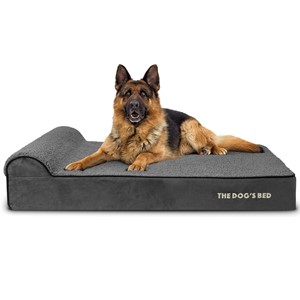
The Dogs Bed XL Grey Orthopedic Rectangle Bed
Price At Time of Publish $130.00 $185.00

KOPEKS Jumbo Orthopedic Rectangular Bed
Price At Time of Publish $130.00 $110.00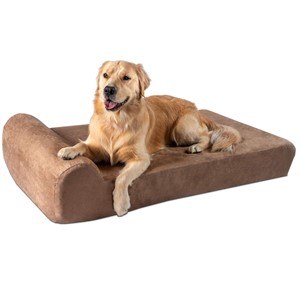
Big Barker XL Orthopedic Rectangle Bed
Price At Time of Publish $130.00 $240.00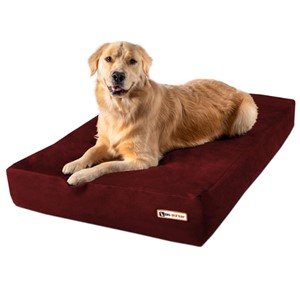
Big Barker XL Burgundy Orthopedic Rectangle Bed
Price At Time of Publish $130.00 $200.00

Serta XL Brown Orthopedic Rectangle Bed
Price At Time of Publish $130.00 $80.00
DogBed4Less XL Blue Orthopedic Rectangle Bed
Price At Time of Publish $130.00 $80.00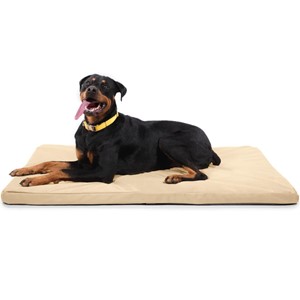
K9 Ballistics XL Sandstone Orthopedic Crate Pad
Price At Time of Publish $130.00 $159.00
Shop Bolster Dog Beds

Brindle XL Gray Orthopedic Bolster Bed
Price At Time of Publish $130.00 $79.00
Bedsure XL Blue Orthopedic Bolster Bed
Price At Time of Publish $130.00 $76.00
Bedsure XL Grey Orthopedic Bolster Bed
Price At Time of Publish $130.00 $60.00
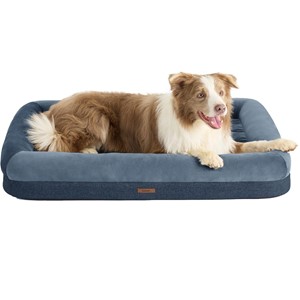
Lesure XL Navy Orthopedic Bolster Bed
Price At Time of Publish $130.00 $40.00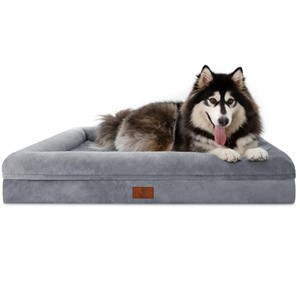
Yiruka XL Grey Orthopedic Bolster Bed
Price At Time of Publish $130.00 $55.00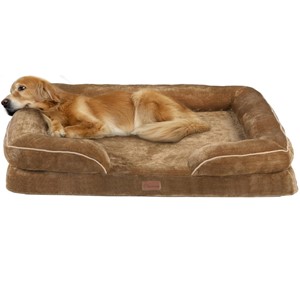
Yitahome XL Brown Orthopedic Bolster Bed
Price At Time of Publish $130.00 $37.00
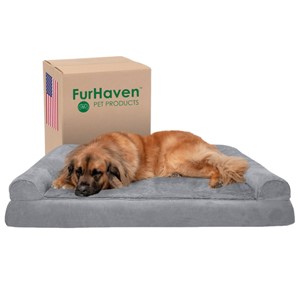
Furhaven XL Gray Orthopedic Bolster Bed
Price At Time of Publish $130.00 $130.00
PetFusion XL Grey Orthopedic Bolster Bed
Price At Time of Publish $130.00 $60.00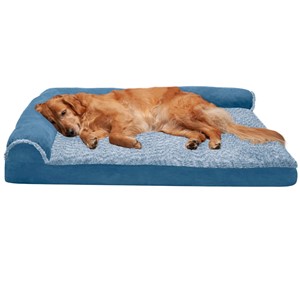
Furhaven Jumbo Blue Orthopedic Bolster Bed
Price At Time of Publish $130.00 $60.00
Shop Elevated Dog Beds
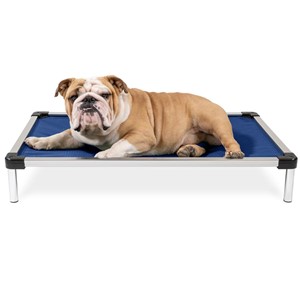
K9 Ballistics Chew Proof Elevated Small Bed
Price At Time of Publish $130.00 $129.00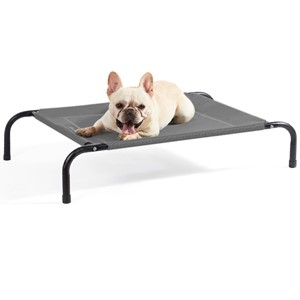
Bedsure Medium Elevated Dog Bed
Price At Time of Publish $130.00 $33.00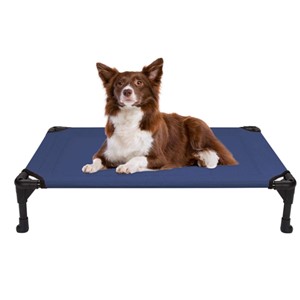
Veehoo Medium Elevated Dog Bed
Price At Time of Publish $130.00 $45.00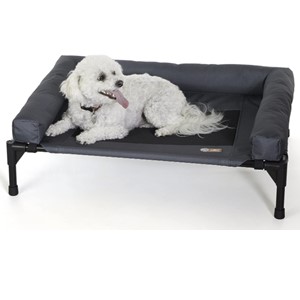
K&H Pet Products Elevated Bolster Dog Bed
Price At Time of Publish $130.00 $57.00
Kuranda Elevated Chew Proof Small Dog Bed
Price At Time of Publish $130.00 $134.00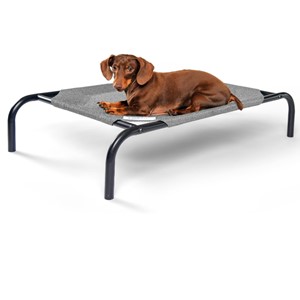
Coolaroo Small Elevated Dog Bed
Price At Time of Publish $130.00 $21.00
Related Articles
Below are some other articles you may be interested in reading. Just select on the topic of interest to learn more about it.
- Best Healthy Dog Food Brands
- Christmas Presents for My Dog
- Crates for Dogs
- Critical Signs Your Dog Needs Help
- Dog Training Techniques
- How To Train a Puppy
- Positive Reinforcement for Dog Training
- Puppy Proofing Your House
- All Dog Breed Rankings
- Training Dog with Treats
- Using Alexa for Dog Behaviors
Go back to the Dog Luxury Beds home page.

